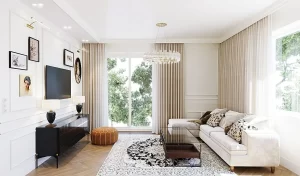How to Design a Child-Friendly Home

Home designs tailored specifically towards children should strike an aesthetic-practical balance; an appealing home should not appear disorganized.
Child-friendly interior designs incorporate some key technical features: round furniture, protective covers for nice couches and no sharp corners that could pose a choking hazard. Plus, there are many stylish options that will help make your home an inviting environment for children to grow up in!
Natural light
An efficiently lit home can give children the energy needed to be active while also encouraging healthy sleeping patterns. Selecting suitable lighting fixtures and installing large windows or sunroofs to allow natural lighting is vital to creating the ideal atmosphere in which to grow up in.
Consider how long-lasting and kid-friendly each material will be before making your selections. Silks may not be suitable as they can easily become damaged from dirty hands and spills; grasscloth wallpaper, however, provides an elegant solution that is also sturdy.
As well as adding playful elements into your home to amuse everyone in it, incorporating playful features that bring smiles is also important for keeping children amused and make guests smile too! Examples may include adding wall art prints that capture kids’ interest or having animal toothbrush holders or quirky clocks around to delight both kids and guests alike. These touches will keep visitors smiling throughout their stay!
Interactive wall elements
Children are constantly exploring their surroundings, making interactive wall elements that promote sensory development vital. Such features may include chalkboards, whiteboards and magnetic boards – giving children their own space that truly feels like theirs.
Parents often worry that their kid-friendly home will quickly become overrun with toys and items, but this doesn’t have to be the case. By being intentional with colour choices, many parents find their kid-friendly home decor can still look stylish while being well organized.
Select durable materials that will withstand wear and tear from children, such as vinyl tile and stain-resistant fabric such as silk. Fabrics like silk may not hold up well under wear from kids, so look for stain resistant options like vinyl and tile instead.
Playful lighting fixtures
Even though children create spills, messes, and wear-and-tear, that shouldn’t force new parents to sacrifice style when designing child-friendly interior ideas for their homes. Kid-friendly design ideas with materials such as tile that are easily cleaned are possible and make an effective statement without compromising style.
Rugs can also make an ideal choice for children as they hide dirt easily while being easily vacuumed or hosed down when accidents arise. Furthermore, washable tiles take maintenance one step further by eliminating the need for scrubbing or soaking altogether.
This home provides an ideal example of how to design a child-friendly home while remaining stylish and contemporary. Boasting beautiful yet durable materials like White Striped Diamonds Mosaic, this family-oriented living area is both practical and beautiful.
Comfortable furniture
Comfort is key when designing a kid-friendly home. Children tend to experience accidents more frequently than adults do, making forgiving materials like rugs essential in covering dirt, stains and debris that accumulate over time. Washable rugs make the job even simpler while saving parents both time and stress by being easily cleanable.
Durability should also be taken into consideration when looking for family-friendly furniture. Avoid materials with sharp corners that could pose a danger to young children; opt instead for wood and leather materials which are easy to keep clean.
Consider storage solutions that make it easy to keep family-friendly spaces organized and tidy, such as slide-out laundry cabinets which offer extra storage without taking up floor space, or porcelain tile which provides modern aesthetics with easy maintenance needs.
Safety
There are many factors to keep in mind when designing a child-friendly home, yet childproofing doesn’t mean compromising on style or your desired aesthetic.
Some parents opt to cover couches with covers to protect from spills and other messes made by children, which can then be removed to reveal beautiful material when older. Doing this helps avoid accidents that might damage furniture while helping prevent accidents that could cause injuries to both people and furniture alike.
Other safety measures may include avoiding furniture with sharp corners and keeping chemicals, medicines and sharp objects out of reach. Some families choose to apply shatter-resistant film on windows and doors to provide extra protection from shattering; but remember that children can be naturally curious; even the best-designed homes may pose hazards that require close supervision in order to avoid injuries.








